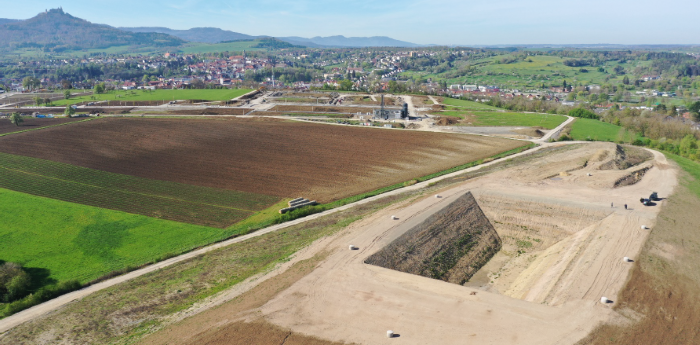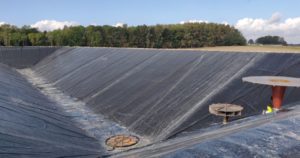Site selection and feasibility assessment for pit thermal energy storage
November 11, 2025
The EU-funded Treasure project aims to process the lessons learned from existing pit thermal energy storage installations in order to simplify the planning and implementation of follow-up initiatives. Per Alex Sørensen from the Danish consultancy company PlanEnergi has developed a special methodology for this purpose. He organizes a series of online workshops in which practitioners and researchers report in detail on the various phases involved in implementing such storage projects and discuss the results with other experts. Based on the recorded workshops, reports have been and will be written, covering every phase from planning, design and construction to operation. We spoke to Sørensen about his experiences with the first two workshops and the lessons learned from them. The first available report covers site selection and feasibility assessment and is available for download here.
Photo: PlanEnergi
Why does Treasure focus on pit thermal energy storage (PTES)? Is this the most promising storage technology among the seasonal storage concepts?
Sørensen: Large-scale pit thermal energy storage systems are the most feasible solution in many locations, whereas alternatives such as deep aquifer storage are only viable at specific sites.
PTES technology was first developed in Sweden and Denmark in the 1980s. Its main advantages include the ability to achieve high storage temperatures and to charge and discharge quickly with high capacity. This contrasts with borehole systems, where the use of soil or rock as the storage medium limits heat transfer speed and overall performance.
You are currently carrying out a series of online workshops, which are the basis for publishing reports about the most important phases of PTES from planning to operation. Which workshops have already taken place and which are planned?
Sørensen: We’ve already organized four workshops – the first focused on screening potential locations, the second on conducting prefeasibility calculations, the third on financing and organizational experiences and the fourth on the authorization process, which often involves overcoming several challenges related to groundwater impact, environmental considerations, and landscape integration. The fifth workshop will focus on the detailed design of the storage system and the technical drawings. We also plan an additional workshop dedicated to the tendering process and construction phase. Finally, the last workshop will cover operation, maintenance, and monitoring.
How are the workshops organized?
Sørensen: We invite experts and researchers who have been involved in the particular phase at a PTES site and discuss their experiences in a closed group. For example, during the workshop on screening locations we analyzed the status and challenges faced by several storage tank initiatives, including projects in Rostock and Hechingen in Germany, Dronninglund in Denmark, and Graz in Austria. We record the entire workshop – about four hours of discussion – and then analyze the presentations and conversations afterward to help draft the report. The first two workshops, focusing on site selection and feasibility assessments, will be compiled into a single report, which is currently being finalized and is available on the Treasure website for download.
What is your major motivation for the workshop series?
Sørensen: Our most important objective is to make experiences gained from demonstrators and previous projects easy to access, so that planners and utility companies can profit from them. We are confident that this will enable us to accelerate the implementation of future PTES projects. We are seeing many district heating companies in Europe that are examining the idea of storing waste heat from industry or reducing peak loads in their grids. There are around 20 follow-up projects in countries such as Germany, France, Denmark, Poland and Serbia.
Other future users of large-scale PTES might be industrial companies because they can have huge amounts of excess heat. For example, cement manufacturers can use PTES to cover internal heating demands during winter stops and also sell heat to district heating utilities.
Learning from case studies is an important approach for your work within Treasure. For the first report you used the case studies of Hjørring-Hirtshals, Dronninglund, Høje Taastrup and Fjernvarme Fyn – all in Denmark. Can you describe the case studies and why they are particularly suitable for looking at lessons learned?
Sørensen: Hjørring-Hirtshals is in the planning phase and you can examine the way to screen sites using geotechnical studies and the integration of PTES into existing structures like quarries or landfills. The utility wanted to have two storage pits of 200,000 m3 each to have a redundant solution and checked the soil conditions at eight different sites. In the report we added a table that gives an overview of the characteristics of three identified locations with parameters like projected nature, land use, cultural heritage and infrastructure. For Dronninglund we studied experiences with the reuse of existing infrastructure – in this case a gravel pit – and for Høje Taastrup an interesting point was how to deal with geotechnical issues.
Assessment of site three at Hjørring-Hirtshals, Denmark, Source: Report “Comprehensive Approach for Pit Thermal Energy Storage Site Selection and Feasibility Assessment“
Another important case study is Fjernvarme Fyn. We used the planned 700,000 m3 PTES there to study the European tender process for feasibility studies and design work. The utility in Fyn aims to reduce peak load demand, which is typically met by fossil fuel boilers. Instead, they use the storage so that they can operate the biomass CHP during periods with high electricity costs and the heat pumps when electricity is cheaper. In the calculations, the utility company considered four charging and discharging cycles over the year. Based on our experience, about 50% of the revenue comes from peak load savings, while the other 50% comes from the flexibility to use low-cost electricity. This represents a completely new business model compared to the first generation of Danish PTES, which primarily stored surplus solar heat during the summer for use in winter heating and increased the solar fraction over the year.
In the report, we’ve outlined the key project details needed for the tendering process and included a table with a matrix for evaluating bids, complete with criteria and weightings.
In the conclusion of the report, you highlight that the successful implementation of PTES depends on careful site selection, comprehensive feasibility studies, and thorough performance assessments. Could you share some of the key lessons you have learned from the case studies?
Sørensen: From the German town Hechingen, for example, we learned that you can build a PTES from excess soil. Uncontaminated surplus soil from construction sites etc. was delivered and deposited, forming a hill on the outskirts of Hechingen. So you actually use this soil for building your PTES. The feasibility study in Hechingen proved the possibility to use the soil landfill as the location for a 18,000 m3 PTES and also for a 7,600 m2 solar collector field (see photo below).
But on a more general basis, with our first report we want to encourage initiators of large-scale PTES to improve their understanding of the land features, environmental limits and geotechnical conditions, in order to reduce potential issues. Furthermore, engaging stakeholders and addressing public concerns at an early planning stage are important for project acceptance and success.

18,000 m3 storage in a landfill near the German town of Hechingen. Behind you see the development of the new housing area, which is connected to the district heating grid
Photo: Hechingen Utility Company
Treasure report (deliverable 2.1): Screening experience: comprehensive approaches for pit thermal energy Storages site selection and feasibility assessment available for download here.
Websites of organizations mentioned in this news article:
Treasure: https://www.treasure-project.eu/
PlanEnergi: https://planenergi.eu/



